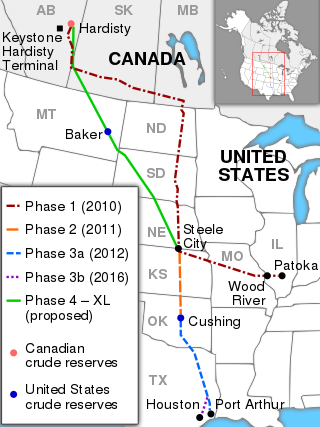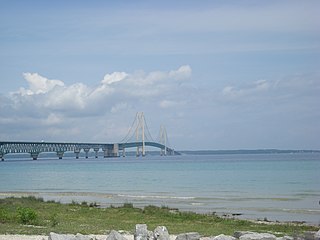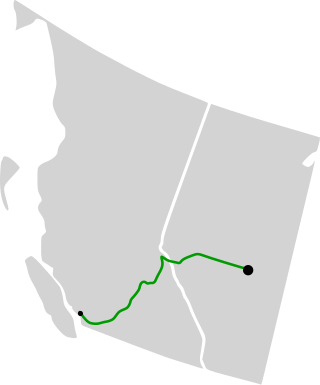Enbridge Inc. is a Canadian multinational pipeline and energy company headquartered in Calgary, Alberta, Canada. Enbridge owns and operates pipelines throughout Canada and the United States, transporting crude oil, natural gas, and natural gas liquids, and also generates renewable energy. Enbridge's pipeline system is the longest in North America and the largest oil export pipeline network in the world. Its crude oil system consists of 28,661 kilometres of pipelines. Its 38,300 kilometre natural gas pipeline system connects multiple Canadian provinces, several US states, and the Gulf of Mexico. The company was formed by Imperial Oil in 1949 as the Interprovincial Pipe Line Company Limited to transport Alberta oil to refineries. Over time, it has grown through acquisition of other existing pipeline companies and the expansion of their projects.
The Enbridge Pipeline System is an oil pipeline system which transports crude oil and dilbit from Canada to the United States. The system exceeds 5,000 kilometres (3,100 mi) in length including multiple paths. More than 3,000 kilometres (1,900 mi) of the system is in the United States while the rest is in Canada and serves the Athabasca oil sands production facilities. Main parts of the system are 2,306-kilometre-long (1,433 mi) Canadian Mainline and 3,057-kilometre-long (1,900 mi) Lakehead System. On average, it delivers 1.4 million barrels per day of crude oil and other products to the major oil refineries in the American Midwest and the Canadian province of Ontario. The Canadian portion is owned by Enbridge, while the U.S. portion is partly owned by that company through Enbridge Energy Partners, LP, formerly known as Lakehead Pipe Line Partners and Lakehead Pipe Line Company.

The Keystone Pipeline System is an oil pipeline system in Canada and the United States, commissioned in 2010 and owned by TC Energy and, as of March 2020, the Government of Alberta. It runs from the Western Canadian Sedimentary Basin in Alberta to refineries in Illinois and Texas, and also to oil tank farms and an oil pipeline distribution center in Cushing, Oklahoma.
The Prairie River is a river in Itasca County, Minnesota. The river is located in northern Minnesota, near the communities of Taconite, Bovey, Grand Rapids, and La Prairie. It is a tributary of the Mississippi River.
The Enbridge Northern Gateway Pipelines were a planned-but-never-built project for a twin pipeline from Bruderheim, Alberta, to Kitimat, British Columbia. The project was active from the mid-2000s to 2016. The eastbound pipeline would have imported natural gas condensate, and the westbound pipeline would have exported diluted bitumen from the Athabasca oil sands to a marine terminal in Kitimat for transportation to Asian markets via oil tankers. The project would have also included terminal facilities with "integrated marine infrastructure at tidewater to accommodate loading and unloading of oil and condensate tankers, and marine transportation of oil and condensate." The CA$7.9 billion project was first proposed in the mid-2000s but was postponed several times. The project plan was developed by Enbridge Inc., a Canadian crude oil and liquids pipeline and storage company.

The Kalamazoo River oil spill occurred in July 2010 when a pipeline operated by Enbridge burst and flowed into Talmadge Creek, a tributary of the Kalamazoo River near Marshall, Michigan. A 6-foot (1.8 m) break in the pipeline resulted in one of the largest inland oil spills in U.S. history. The pipeline carries diluted bitumen (dilbit), a heavy crude oil from Canada's Athabasca oil sands to the United States. Cleanup took five years. Following the spill, the volatile hydrocarbon diluents evaporated, leaving the heavier bitumen to sink in the water column. Thirty-five miles (56 km) of the Kalamazoo River were closed for clean-up until June 2012, when portions of the river were re-opened. On March 14, 2013, the Environmental Protection Agency (EPA) ordered Enbridge to return to dredge portions of the river to remove submerged oil and oil-contaminated sediment.

Idle No More is an ongoing protest movement, founded in December 2012 by four women: three First Nations women and one non-Native ally. It is a grassroots movement among the Indigenous peoples in Canada comprising the First Nations, Métis and Inuit peoples and their non-Indigenous supporters in Canada, and to a lesser extent, internationally. It has consisted of a number of political actions worldwide, inspired in part by the liquid diet hunger strike of Attawapiskat Chief Theresa Spence and further coordinated via social media. A reaction to alleged legislative abuses of Indigenous treaty rights by then Prime Minister Stephen Harper and the Conservative federal government, the movement takes particular issue with the omnibus bill Bill C-45. The popular movement has included round dances in public places and blockades of rail lines.

Enbridge Line 5 is a 645-mile oil pipeline owned by the Canadian multinational corporation Enbridge. Constructed in 1953, the pipeline conveys crude oil from western Canada to eastern Canada via the Great Lakes states. Line 5 is part of the Enbridge Lakehead System and passes under the environmentally sensitive Straits of Mackinac, which connect Lake Michigan to Lake Huron. The 30-inch pipeline carries 540,000 barrels (86,000 m3) of synthetic crude, natural gas liquids, sweet crude, and light sour crude per day as of 2013.

The Trans Mountain Pipeline System, or simply the Trans Mountain Pipeline(TMPL), is a multiple product pipeline system that carries crude and refined products from Edmonton, Alberta, to the coast of British Columbia, Canada.
The Sandpiper pipeline was a proposed 616-mile-long (991 km) underground oil pipeline project in the United States. It would have carried light crude oil from the Bakken oil fields in Northwest North Dakota, through Minnesota, to Superior, Wisconsin.

The Dakota Access Pipeline Protests, also known by the hashtag #NoDAPL, were a series of grassroots Native American protests against the construction of the Dakota Access Pipeline in the northern United States that began in April 2016. Protests ended on February 23, 2017 when National Guard and law enforcement officers evicted the last remaining protesters.

Matthew "Matt" Grossell is an American politician serving in the Minnesota House of Representatives since 2017. A member of the Republican Party of Minnesota, Grossell represents District 2A in northwestern Minnesota, which includes the city of Bemidji and parts of Beltrami, Clearwater, and Lake of the Woods Counties.
The Line 3 pipeline is an oil pipeline owned by the Canadian multinational Enbridge. Operating since 1968, it runs 1,031 miles (1,659 km) from Hardisty, Alberta, Canada to Superior, Wisconsin, United States.

The Unistʼotʼen Camp is a protest camp and indigenous healing centre in northern British Columbia, Canada. It is located within the traditional territory of the Unist'otʼen clan of the Wetʼsuwetʼen First Nation peoples. Established after the proposal of several pipeline projects in the area, it is situated where several pipelines will pass, as a means to block their construction.
From January to March 2020, a series of civil disobedience protests were held in Canada over the construction of the Coastal GasLink Pipeline (CGL) through 190 kilometres (120 mi) of Wetʼsuwetʼen First Nation territory in British Columbia (BC), land that is unceded. Other concerns of the protesters were Indigenous land rights, the actions of police, land conservation, and the environmental impact of energy projects.
The Valve Turners is a label given to, and claimed by, environmental activists who take direct action against the fossil fuel industry by illegally turning emergency shut-off valves to close oil pipelines. Valve Turners have sought to use the necessity defense in court, arguing that they were obligated to act in the face of the imminent threat of climate change to which oil pipelines contribute. In some cases, they have invoked Indigenous sovereignty and treaty rights.
The Line 3 oil spill was a 1.7 million gallon crude oil spill in Minnesota on March 3, 1991. The Line 3 pipeline, then owned by the Lakehead Pipeline Company, ruptured on a wetland near Grand Rapids, Minnesota, spilling oil into the Prairie River, a tributary of the Mississippi River. It was the largest inland oil spill in the history of the United States.

Tara Houska Zhaabowekwe is a tribal attorney, land defender and climate justice activist.

The Dakota Access Pipeline (DAPL) or Bakken pipeline is a 1,172-mile-long (1,886 km) underground pipeline in the United States that has the ability to transport up to 750,000 barrels of light sweet crude oil per day. It begins in the shale oil fields of the Bakken Formation in northwest North Dakota and continues through South Dakota and Iowa to an oil terminal near Patoka, Illinois. Together with the Energy Transfer Crude Oil Pipeline from Patoka to Nederland, Texas, it forms the Bakken system. The pipeline transports 40 percent of the oil produced in the Bakken region.

















